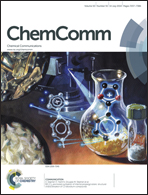Formation of ceramophilic chitin and biohybrid materials enabled by a genetically engineered bifunctional protein†
Abstract
A bifunctional protein composed of a highly negatively charged oyster shell protein and a chitin-binding domain enabled the formation of biohybrid materials through non-covalent surface modification of chitin nanofibres. The results demonstrate that specific biomolecular interactions offer a route for the formation of biosynthetic materials.


 Please wait while we load your content...
Please wait while we load your content...